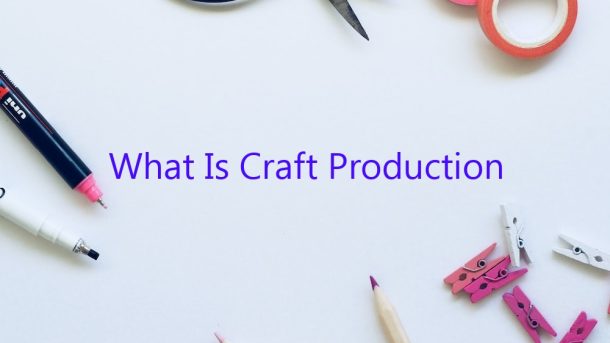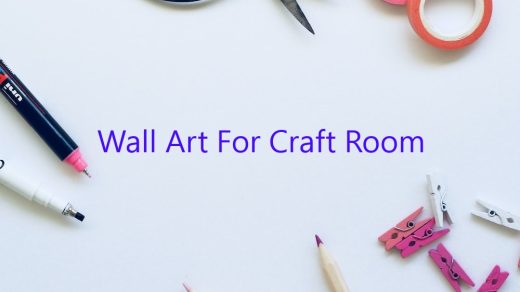Craft production has been a mainstay of human civilization for centuries. Across cultures, craft production has taken on many different forms, but the fundamental premise remains the same: creating objects or artwork through a process of skilled handiwork.
Though the term “craft production” is often used interchangeably with “artisanal production,” there is a key distinction between the two. While artisanal production refers specifically to the production of goods through manual labor, craft production can encompass a wider range of objects, including both handmade and mass-produced items.
One of the defining characteristics of craft production is the emphasis on quality and detail. Craft producers are typically dedicated to using time-tested techniques and high-quality materials to create products that are both beautiful and durable. In many cases, craft production also involves a certain level of customization, allowing consumers to choose from a variety of designs and finishes.
Today, there is a growing interest in artisanal and craft products, as consumers seek out unique, one-of-a-kind items that reflect their personal style. In an age where so much of our lives is dominated by mass-produced goods, the handmade and the artisanal are more important than ever.
Contents
What is craft production examples?
Craft production is the process of creating objects by hand, often with skill and attention to detail. While the term can be used to describe any type of handmade object, it is often used in reference to artisanal products, which are often made with traditional techniques and materials.
Examples of craft production can be found in a variety of industries, from furniture making to pottery. In many cases, craft production is used to create high-quality, unique objects that are not available at mass-market retailers.
One of the benefits of craft production is that it often results in products with a high degree of quality and individuality. This is due, in part, to the fact that most crafts are created by hand, rather than through automated processes.
Craft production can also be a source of income for artisans, who often sell their products through local markets, online stores, or directly to consumers.
There are a number of factors that contribute to the success of craft production. These include the quality of the products, the level of skill and artistry of the artisan, and the uniqueness of the designs.
Craft production is a time-consuming process, and artisans often require a high level of skill to produce quality products. This can make it difficult for artisans to compete with mass-produced items that are available at lower prices.
Nevertheless, the popularity of artisanal products is on the rise, as more and more consumers are looking for unique, high-quality items. This has helped to create a growing demand for craft production, and has led to the emergence of a number of artisan-centric businesses and markets.
Overall, craft production is a process that results in unique, high-quality objects. It requires a high level of skill and artistry, and can be difficult to compete with mass-produced items. Nevertheless, the popularity of artisanal products is on the rise, and there is a growing demand for craft production.
What is craft production in operations management?
Craft production is a term used in operations management that refers to the production of goods or services that are made to order and are highly customized. These items are often unique and require a high degree of skill to produce. Craft production is often used to describe the production of goods that are made by hand, such as furniture, jewelry, and clothing.
Craft production is often considered to be a more labor-intensive and expensive way to produce goods. However, it can also be seen as a way to produce high-quality items that are tailored to the specific needs of the customer. In order to be successful, businesses that use craft production must be able to manage the production process effectively and efficiently, while also ensuring that the customer’s needs are met.
There are several factors that businesses must consider when implementing a craft production process. These include the type of product being produced, the skills of the workforce, the level of customization required, and the available resources. Businesses must also be able to manage the flow of materials and labor through the production process, and ensure that the finished products meet the customer’s specifications.
Craft production can be a successful way to produce high-quality goods, but it is not always appropriate for every type of product. businesses should carefully consider the needs of their customers and the resources available before deciding whether or not to use a craft production process.
What is craft production and mass production?
Craft production is a type of manufacturing process that is often considered to be more artisanal in nature, and involves making products by hand with a high degree of attention to detail. Mass production, on the other hand, is a type of manufacturing process that is often considered to be more mechanized and industrialized, and involves making products in large quantities using machinery.
There are a number of key differences between craft production and mass production. Firstly, craft production often involves making products by hand, while mass production involves making products using machinery. Secondly, craft production often involves making products with a high degree of attention to detail, while mass production often involves making products in large quantities and with less attention to detail. Thirdly, craft production is often considered to be more artisanal in nature, while mass production is often considered to be more mechanized and industrialized.
Overall, there are a number of reasons why craft production is often considered to be preferable to mass production. Firstly, craft production often results in products that are of a higher quality and are made with more attention to detail. Secondly, craft production is often more environmentally friendly, as it does not involve the use of as much machinery. Thirdly, craft production is often more sustainable, as it does not rely on the use of finite resources. Finally, craft production is often more socially responsible, as it often provides jobs for people in developing countries.
What is the process of craft?
Crafting is an ancient art form that involves making or creating something with one’s hands. The process of crafting can be used to create objects such as pottery, jewelry, and furniture, or to create works of art. While the process of crafting can be used to create a wide variety of objects, there are some basic steps that are common to all forms of crafting.
The first step in the crafting process is usually to gather the necessary materials. This may involve finding the right type of wood to make a piece of furniture, or finding the right beads and clasps to make a piece of jewelry.
After the materials are gathered, the next step is usually to plan the project. This may involve sketching out a design for the object or determining how the different parts of the project will be put together.
The next step is to begin creating the project. This may involve cutting and shaping the materials, stringing the beads, or assembling the furniture.
The final step is usually to finish the project. This may involve painting or varnishing the object, adding the final touches to the jewelry, or assembling the furniture.
The process of crafting can be a fun and rewarding way to create beautiful objects or works of art. It can also be a great way to learn new skills and techniques.
What are the 5 types of crafts?
Crafting is an enjoyable and relaxing activity that can be done by people of all ages. There are many different types of crafts, each with its own set of supplies and techniques. Here are the five most popular types of crafts:
1. Sewing
Sewing is a craft that has been around for centuries. It involves using a needle and thread to stitch fabric together. Sewing can be used to create a variety of items, such as clothing, quilts, and home decor.
2. Knitting
Knitting is a craft that is centuries old, and it involves using two needles to create fabric from yarn. Knitting can be used to create a variety of items, such as sweaters, hats, and blankets.
3. Crochet
Crochet is a craft that is similar to knitting, but it uses a hook instead of needles. Crochet can be used to create a variety of items, such as clothing, blankets, and home decor.
4. Painting
Painting is a craft that can be done with any type of paint, on any type of surface. Painting can be used to create a variety of items, such as paintings, murals, and tattoos.
5. Pottery
Pottery is the art of shaping clay into vessels ornaments, and other objects. Pottery can be used to create a variety of items, such as bowls, vases, and sculptures.
What are the 5 materials of craft?
Craft can be defined as an activity that is undertaken for enjoyment and involves making something with one’s hands. It can be a hobby or a profession, and there are a number of materials that can be used in the process. In this article, we will take a look at five of the most commonly used materials in craft.
Wood
Wood is one of the most versatile materials that can be used in craft. It can be carved, sanded and stained to create a wide variety of objects, from simple boxes and bangles to intricate carvings and furniture. Wood is also strong and durable, making it a popular choice for items that need to be sturdy and long lasting.
Glass
Glass is another material that is often used in craft, and it can be used to create a wide variety of objects. It can be cut and shaped to create bowls, vases, and other decorative items, or it can be used to create pieces that are functional, such as drinking glasses or windows. Glass is also a durable material, and it can be used to create items that will last for many years.
Cloth
Cloth is a versatile material that can be used in a wide variety of craft projects. It can be used to create soft furnishings, such as curtains and cushions, or it can be used to create items that are more decorative, such as quilts and wall hangings. Cloth is also a relatively cheap material, which makes it a popular choice for craft projects.
Metal
Metal is a popular material for craft projects, particularly when items need to be sturdy or durable. It can be used to create a wide variety of objects, from kitchen utensils to jewelry. Metal can also be decorated or engraved to create beautiful items that are both decorative and functional.
Paper
Paper is one of the most commonly used materials in craft, and it can be used to create a wide variety of objects. It can be cut and folded to create cards, gift boxes, and other decorative items, or it can be used to create items that are more practical, such as notebooks and folders. Paper is also a relatively cheap material, which makes it a popular choice for craft projects.
What are the 3 types of crafts?
There are three types of crafts: functional, decorative, and sculptural.
Functional crafts are objects that have a specific purpose, such as a bowl that can be used to hold fruit or a mug that can be used to drink coffee. Decorative crafts are objects that are meant to be pleasing to the eye, such as a vase that is decorated with a floral design. Sculptural crafts are objects that are meant to be viewed from all angles, such as a statue that is carved out of a block of marble.
The three types of crafts can be further divided into subtypes. Functional crafts can be further divided into utilitarian and artisanal objects. Decorative crafts can be further divided into folk art and high art. Sculptural crafts can be further divided into representational and nonrepresentational objects.
The three types of crafts are important because they allow people to express their creativity in different ways. Functional crafts allow people to create useful objects, decorative crafts allow people to create beautiful objects, and sculptural crafts allow people to create objects that are both useful and beautiful.




